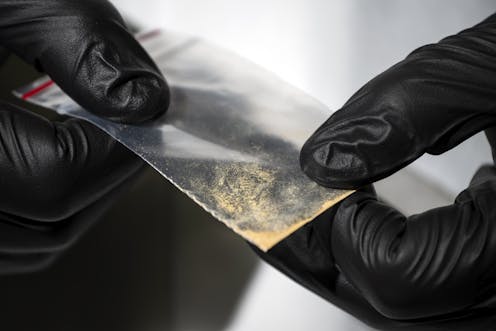Treatment as prevention – the facts behind PrEP
 Treatment can be prevention.Image of pill via nito/Shutterstock
Treatment can be prevention.Image of pill via nito/ShutterstockEver since combination antiretroviral therapy (ART) was introduced in 1996, HIV has been transformed from a fatal diagnosis to a chronic and manageable condition for many people. ART made it possible for HIV-positive individuals to effectively control and suppress the virus circulating in their bodies.
An added benefit is that a person who is on ART and has no evidence of virus in his or her blood is much less likely (and possibly unlikely) to transmit the virus to others. This is called Treatment as Prevention, or TasP. In the US, only about 28% of people with HIV manage to control the virus to this point.
If effective treatment can reduce the risk of someone who is HIV-positive transmitting the virus to someone else, can a similar treatment be used to protect people who are HIV-negative from becoming HIV-positive in the first place? This is called pre-exposure prophlyaxis, or PrEP.
PrEP is a technique where a person who is HIV-negative can potentially offset becoming HIV-positive (the medical term for this is seroconversion) by taking an antiviral medication. The best known and best studied PrEP treatment is Truvada (tenofovir/emtricitabine). Truvada is one of many drugs used to treat HIV and is the only FDA approved medication for PrEP.
Numerous trials have demonstrated that Truvada is effective for PrEP. But despite this evidence, PrEP remains hotly debated in some circles. The result of these destructive debates is that we may be missing the opportunity to harness the full potential of PrEP.
PrEP does not lead to riskier behavior
A vocal few argue that PrEP will lead to higher rates of condomless sex, and perhaps to a higher likelihood of transmission of sexually transmitted infections besides HIV. But this has yet to proven true. In fact, findings from the Pre-exposure Prophylaxis Initiative trial (iPrEX), a study of gay men and transgender women, rates of condomless sex were not found increase.
Until data suggest otherwise, we should be very careful in exaggerating this potential negative health consequence of PrEP. Moreover, this argument against PrEP may serve only to stigmatize and shame sexual behavior. This is a particular risk for gay and transgender populations that continue to fight stigma on many levels.
The trouble with a once-a-day-pill
Critics often point to problems with the current PrEP formulation — one pill, taken once a day. They argue that PrEP is only effective if taken properly, and people do not always adhere to a pill-a-day regimen. To some extent, there is some truth to this concern.
The iPrEX study found that using PrEP consistently resulted in a 43.8% reduction in the risk of contracting HIV. But it was not fool proof. Adherence to a daily medication is a tall order. And even HIV-positive individuals struggle with medication adherence, so this is cause for concern. Among those who became HIV-positive (or “seroconverted”) during the course of the study, adherence to the drug regimen was less than perfect. Those who took the drug consistently had the highest levels of protection against HIV infection.
But, the issues with a daily medication aren’t necessarily a reason to discount PrEP. A trial conducted in Europe and Canada (IPERGAY) showed that intermittent use of PrEP may be as effective as strict daily dosing and is associated with good adherence.
Still the effectiveness of PrEP relies on human behavior. And without the proper social support and health structures in place, people may not take PrEP as strictly as they should. With this in mind, we can’t expect PrEP and TasP to be magic bullets and prevent all future infections.
There is ongoing development of injectable forms for antivirals that can be taken a few times a year, instead of every day. Our own work on young gay men has demonstrated a high preference for such an injectable over a once-a-day pill.
PrEP and privilege
With the evidence suggesting the PrEP is effective, even if not taken consistently, and doesn’t necessarily lead to risky behavior, why does there continue to be a debate over whether it is a good thing? And what purpose does this debate serve? Researchers and academics have the privilege of engaging in intellectual back and forth about PrEP and its role in fighting this epidemic. But what about those with less privilege and power or awareness about PrEP and its role in fighting the epidemic?
In an ongoing study of young adult sexual minority men conducted at my research center (the P18 Cohort Study), preliminary data collected this summer and fall on some 200 young men indicate that 25% of 22-23-year-olds have never heard of PrEP even when it was defined for them, and only 4% had ever used it.
Another study conducted in the US, between 2011 and 2013, found only 1,744 prescriptions for PrEP, the majority to women in southern US states, and that just 37% of heath-care providers surveyed had prescribed Truvada as PrEP.
However, the landscape is changing. There has been widespread discussion and educational initiatives aimed at gay men in the last year. New York state has adopted a plan to bring an end to the AIDS epidemic that includes PrEP as one element to prevent new infections. Still, coupled with the findings from our own study of sexual minority men, it appears that there is still much more work to be done to educate and make PrEP accessible, despite the fact that the drug is covered by health insurance.
For many, the stigma of HIV is very real, and there are concerns that others may assume, without full knowledge, that a person taking Truvada is HIV-positive, a situation that may cause unease in some communities where being HIV-positive is still considered sinful or shameful. These are circumstances that also need to be considered as we seek to roll out PrEP more widely.
Perry N Halkitis receives funding from NIH.
Read more http://theconversation.com/treatment-as-prevention-the-facts-behind-prep-34397













